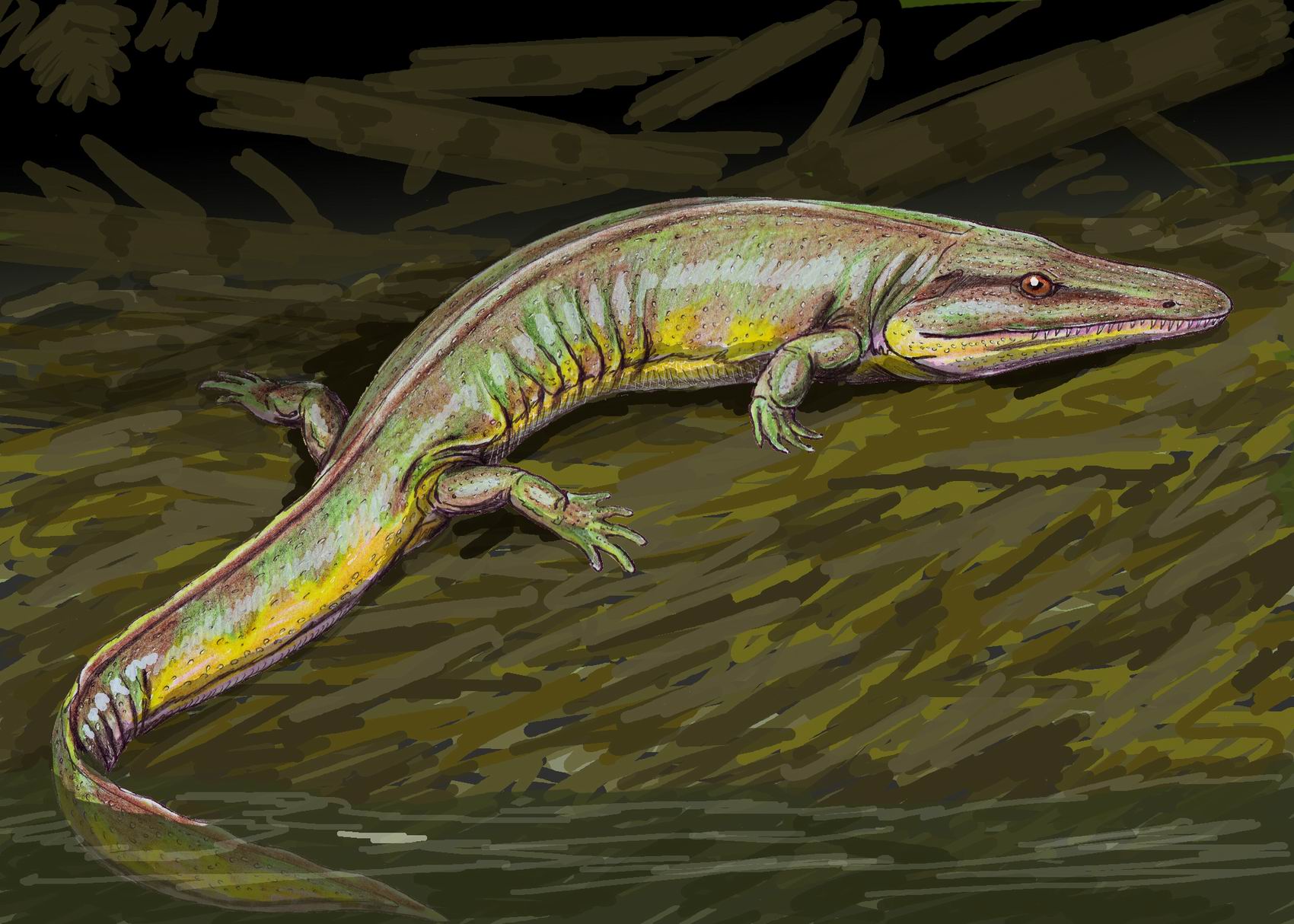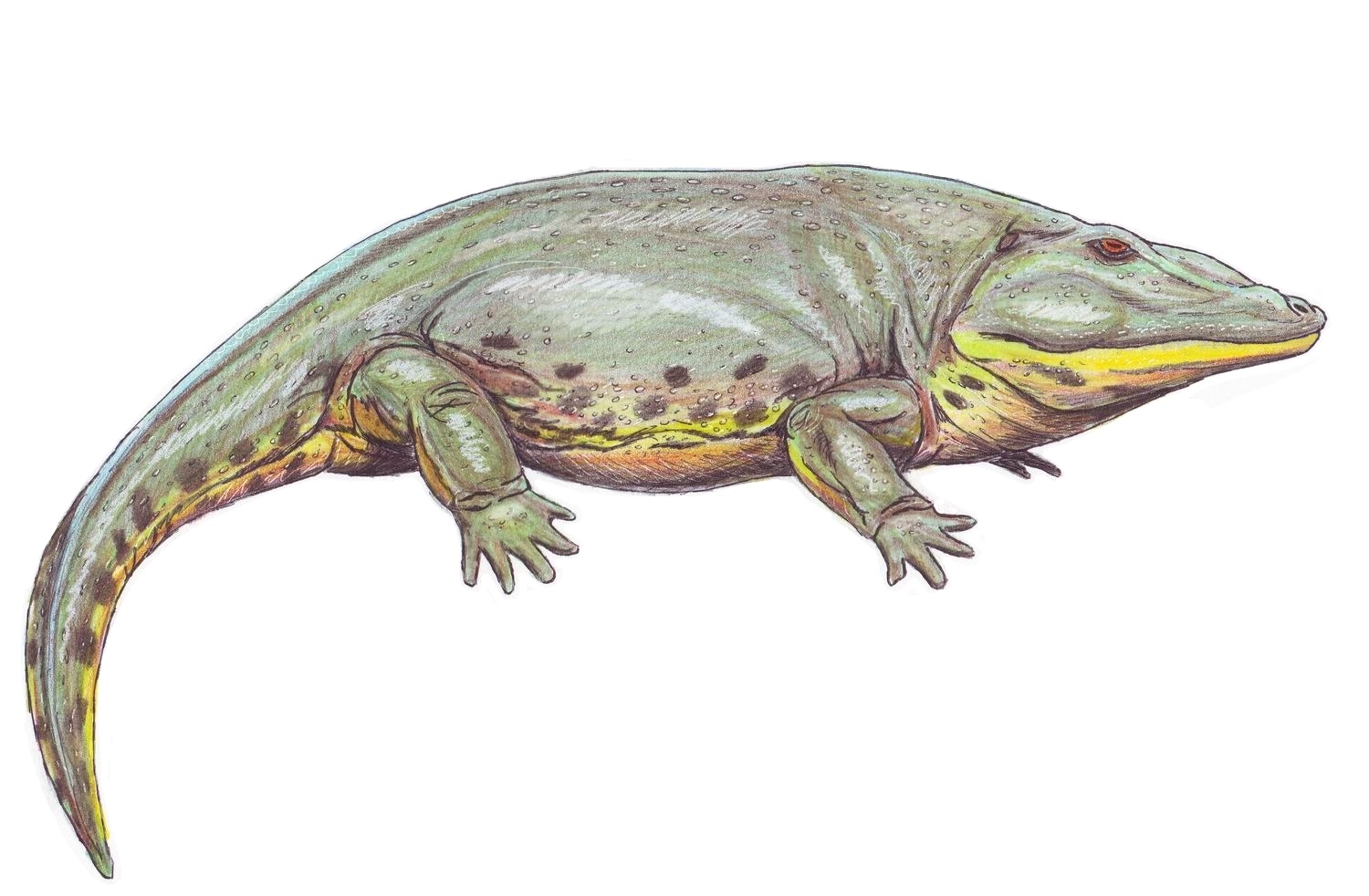|
Edopidae
''Edops'' ('swollen face') is an extinct genus of temnospondyl amphibian from the Early Permian Period. Unlike more advanced temnospondyls of the time, such as ''Eryops'', ''Edops'' exhibited an archaic pattern of palatal bones, and still possessed various additional bones at the back of the skull. Edopoids also had particularly big premaxillae (the bones that form the tip of the snout) and proportionally small external nostrils. Within the clade, the most basal member seems to be ''Edops'' from the Early Permian Archer City Formation of the US, a broad-skulled animal with large palatal teeth. ''Edops'' was fairly big, at in length. Fragmentary remains from the Viséan of Scotland appear to come from ''Edops'' or a close relative and hence predate the type Edops material of the Permian. The American paleontologist Alfred Sherwood Romer Alfred Sherwood Romer (December 28, 1894 – November 5, 1973) was an American paleontologist and biologist and a specialist in vertebrate ... [...More Info...] [...Related Items...] OR: [Wikipedia] [Google] [Baidu] |
Edopoids
Edopoidea is a clade of primitive temnospondyl amphibians including the genus ''Edops'' and the family Cochleosauridae. Edopoids are known from the Late Carboniferous and Early Permian of North America and Europe, and the Late Permian of Africa. They are among the most basal temnospondyls, and possess a number of primitive features that were lost in later members of the group. Description Edopoids are relatively large temnospondyls, with many species estimated to have grown several meters in length. The skull of ''Edops'' is broad while those of cochleosaurids are narrower and elongated. Distinguishing features of edopoids include the presence of an intertemporal bone that is absent in all other temnospondyls, and the lack of a pineal foramen, a small hole on the skull roof of many early tetrapods (young individuals still possess this hole). Relative to other temnospondyls, edopoids also have enlarged premaxillae, maxillae, and nasal bones in the snout region, which constr ... [...More Info...] [...Related Items...] OR: [Wikipedia] [Google] [Baidu] |
Temnospondyl
Temnospondyli (from Greek language, Greek τέμνειν, ''temnein'' 'to cut' and σπόνδυλος, ''spondylos'' 'vertebra') is a diverse order (biology), order of small to giant tetrapods—often considered Labyrinthodontia, primitive amphibians—that flourished worldwide during the Carboniferous, Permian, and Triassic periods. A few species continued into the Jurassic and Cretaceous periods. Fossils have been found on every continent. During about 210 million years of evolutionary history, they adapted to a wide range of habitats, including freshwater, terrestrial, and even coastal marine environments. Their life history is well understood, with fossils known from the larval stage, metamorphosis, and maturity. Most temnospondyls were semiaquatic, although some were almost fully terrestrial, returning to the water only to breed. These temnospondyls were some of the first vertebrates fully adapted to life on land. Although temnospondyls are considered amphibians, many had cha ... [...More Info...] [...Related Items...] OR: [Wikipedia] [Google] [Baidu] |
Permian
The Permian ( ) is a geologic period and stratigraphic system which spans 47 million years from the end of the Carboniferous Period million years ago (Mya), to the beginning of the Triassic Period 251.9 Mya. It is the last period of the Paleozoic Era; the following Triassic Period belongs to the Mesozoic Era. The concept of the Permian was introduced in 1841 by geologist Sir Roderick Murchison, who named it after the region of Perm in Russia. The Permian witnessed the diversification of the two groups of amniotes, the synapsids and the sauropsids ( reptiles). The world at the time was dominated by the supercontinent Pangaea, which had formed due to the collision of Euramerica and Gondwana during the Carboniferous. Pangaea was surrounded by the superocean Panthalassa. The Carboniferous rainforest collapse left behind vast regions of desert within the continental interior. Amniotes, which could better cope with these drier conditions, rose to dominance in place of their am ... [...More Info...] [...Related Items...] OR: [Wikipedia] [Google] [Baidu] |
1953 In Paleontology
Plants Angiosperms Dinosaurs Newly named dinosaurs Data courtesy of George Olshevsky's dinosaur genera list. Synapsids Non-mammalian References {{portal, Paleontology 1950s in paleontology Paleontology Paleontology (), also spelled palaeontology or palæontology, is the scientific study of life that existed prior to, and sometimes including, the start of the Holocene epoch (roughly 11,700 years before present). It includes the study of fossi ... Paleontology 3 ... [...More Info...] [...Related Items...] OR: [Wikipedia] [Google] [Baidu] |
Alfred Romer
Alfred Sherwood Romer (December 28, 1894 – November 5, 1973) was an American paleontologist and biologist and a specialist in vertebrate evolution. Biography Alfred Romer was born in White Plains, New York, the son of Harry Houston Romer and his wife, Evalyn Sherwood. He was educated at White Plains High School. He studied at Amherst College for his Bachelor of Science Honours degree in biology, then at Columbia University for an M.Sc in Biology and a doctorate in zoology in 1921. Romer joined the department of geology and paleontology at the University of Chicago as an associate professor in 1923. He was an active researcher and teacher. His collecting program added important Paleozoic specimens to Chicago's Walker Museum of Paleontology. In 1934 he was appointed professor of biology at Harvard University. In 1946, he became director of the Harvard Museum of Comparative Zoology (MCZ). In 1954 Romer was awarded the Mary Clark Thompson Medal from the National Academy of Sc ... [...More Info...] [...Related Items...] OR: [Wikipedia] [Google] [Baidu] |
1942 In Paleontology
Conodonts Dinosaurs Newly named dinosaurs Data courtesy of George Olshevky's dinosaur genera list. Synapsids Non-mammalian References {{portal, Paleontology 1940s in paleontology Paleontology Paleontology (), also spelled palaeontology or palæontology, is the scientific study of life that existed prior to, and sometimes including, the start of the Holocene epoch (roughly 11,700 years before present). It includes the study of fossi ... Paleontology 2 ... [...More Info...] [...Related Items...] OR: [Wikipedia] [Google] [Baidu] |
Genus
Genus ( plural genera ) is a taxonomic rank used in the biological classification of extant taxon, living and fossil organisms as well as Virus classification#ICTV classification, viruses. In the hierarchy of biological classification, genus comes above species and below family (taxonomy), family. In binomial nomenclature, the genus name forms the first part of the binomial species name for each species within the genus. :E.g. ''Panthera leo'' (lion) and ''Panthera onca'' (jaguar) are two species within the genus ''Panthera''. ''Panthera'' is a genus within the family Felidae. The composition of a genus is determined by taxonomy (biology), taxonomists. The standards for genus classification are not strictly codified, so different authorities often produce different classifications for genera. There are some general practices used, however, including the idea that a newly defined genus should fulfill these three criteria to be descriptively useful: # monophyly – all descendants ... [...More Info...] [...Related Items...] OR: [Wikipedia] [Google] [Baidu] |
Amphibian
Amphibians are tetrapod, four-limbed and ectothermic vertebrates of the Class (biology), class Amphibia. All living amphibians belong to the group Lissamphibia. They inhabit a wide variety of habitats, with most species living within terrestrial animal, terrestrial, fossorial, arboreal or freshwater aquatic ecosystems. Thus amphibians typically start out as larvae living in water, but some species have developed behavioural adaptations to bypass this. The young generally undergo metamorphosis from larva with gills to an adult air-breathing form with lungs. Amphibians use their skin as a secondary respiratory surface and some small terrestrial salamanders and frogs lack lungs and rely entirely on their skin. They are superficially similar to reptiles like lizards but, along with mammals and birds, reptiles are amniotes and do not require water bodies in which to breed. With their complex reproductive needs and permeable skins, amphibians are often ecological indicators; in re ... [...More Info...] [...Related Items...] OR: [Wikipedia] [Google] [Baidu] |
Permian Period
The Permian ( ) is a geologic period and stratigraphic system which spans 47 million years from the end of the Carboniferous Period million years ago (Mya), to the beginning of the Triassic Period 251.9 Mya. It is the last period of the Paleozoic Era; the following Triassic Period belongs to the Mesozoic Era. The concept of the Permian was introduced in 1841 by geologist Sir Roderick Murchison, who named it after the region of Perm in Russia. The Permian witnessed the diversification of the two groups of amniotes, the synapsids and the sauropsids (reptiles). The world at the time was dominated by the supercontinent Pangaea, which had formed due to the collision of Euramerica and Gondwana during the Carboniferous. Pangaea was surrounded by the superocean Panthalassa. The Carboniferous rainforest collapse left behind vast regions of desert within the continental interior. Amniotes, which could better cope with these drier conditions, rose to dominance in place of their amphibia ... [...More Info...] [...Related Items...] OR: [Wikipedia] [Google] [Baidu] |
Eryops
''Eryops'' (; from Greek , , 'drawn-out' + , , 'face', because most of its skull was in front of its eyes) is a genus of extinct, amphibious temnospondyls. It contains the single species , the fossils of which are found mainly in early Permian (about 295 million years ago) rocks of the Texas Red Beds, located in Archer County, Texas. Fossils have also been found in late Carboniferous period rocks from New Mexico. Several complete skeletons of ''Eryops'' have been found in lower Permian rocks, but skull bones and teeth are its most common fossils. Description ''Eryops'' averaged a little over long and could grow up to , making them among the largest land animals of their time. Adults weighed between . The skull was proportionately large, being broad and flat and reaching lengths of . It had an enormous mouth with many curved teeth like the frog. Its teeth had enamel with a folded pattern, leading to its early classification as a "labyrinthodont" ("maze toothed"). The sh ... [...More Info...] [...Related Items...] OR: [Wikipedia] [Google] [Baidu] |
Archer City Formation
The Archer City Formation is a geologic formation in Texas. It preserves fossils dating back to the Permian period. See also * List of fossiliferous stratigraphic units in Texas * Paleontology in Texas Paleontology in Texas refers to paleontological research occurring within or conducted by people from the U.S. state of Texas. Author Marian Murray has remarked that "Texas is as big for fossils as it is for everything else." Some of the most imp ... References * Permian geology of Texas {{Permian-stub ... [...More Info...] [...Related Items...] OR: [Wikipedia] [Google] [Baidu] |
Alfred Sherwood Romer
Alfred Sherwood Romer (December 28, 1894 – November 5, 1973) was an American paleontologist and biologist and a specialist in vertebrate evolution. Biography Alfred Romer was born in White Plains, New York, the son of Harry Houston Romer and his wife, Evalyn Sherwood. He was educated at White Plains High School. He studied at Amherst College for his Bachelor of Science Honours degree in biology, then at Columbia University for an M.Sc in Biology and a doctorate in zoology in 1921. Romer joined the department of geology and paleontology at the University of Chicago as an associate professor in 1923. He was an active researcher and teacher. His collecting program added important Paleozoic specimens to Chicago's Walker Museum of Paleontology. In 1934 he was appointed professor of biology at Harvard University. In 1946, he became director of the Harvard Museum of Comparative Zoology (MCZ). In 1954 Romer was awarded the Mary Clark Thompson Medal from the National Academy of Sc ... [...More Info...] [...Related Items...] OR: [Wikipedia] [Google] [Baidu] |






.png)
